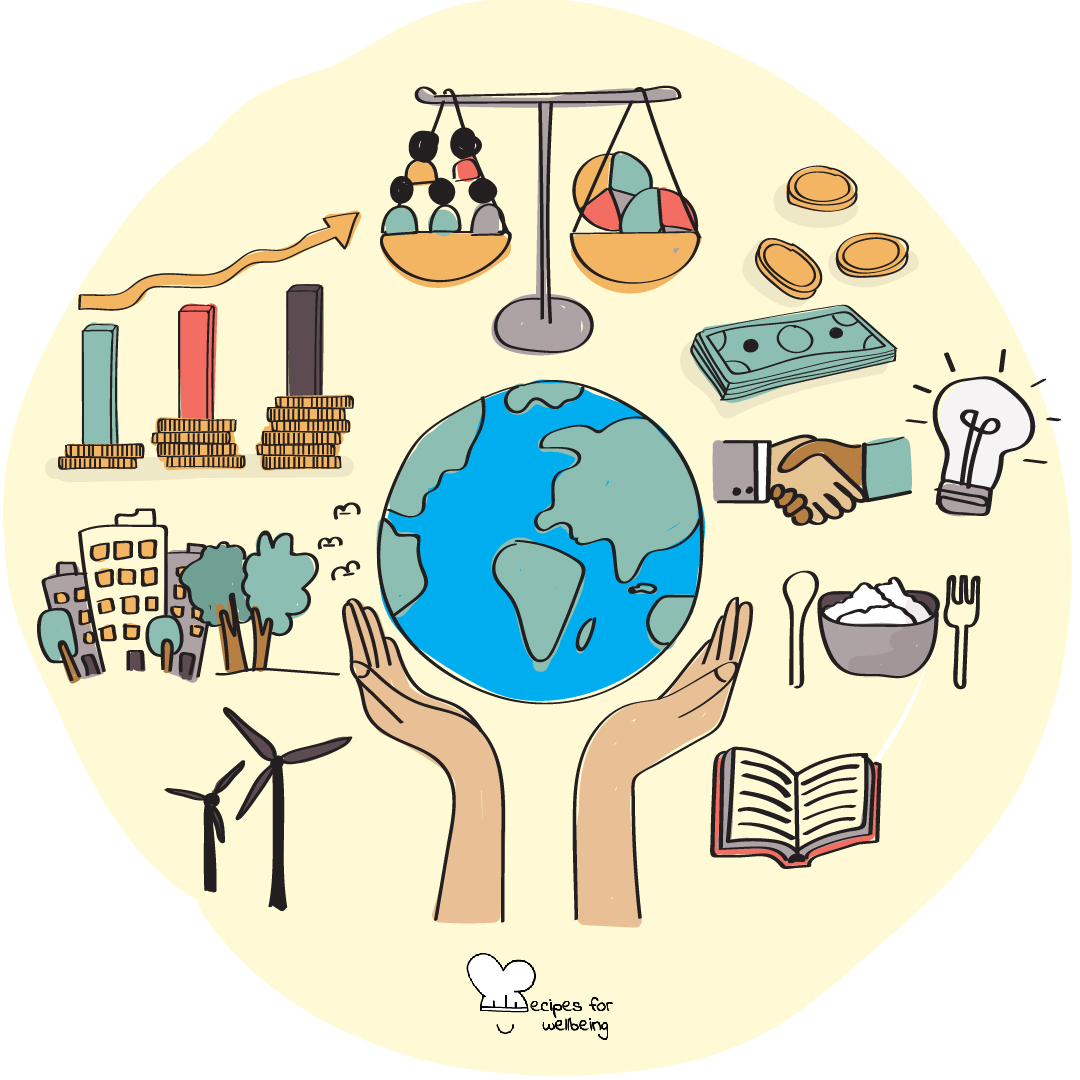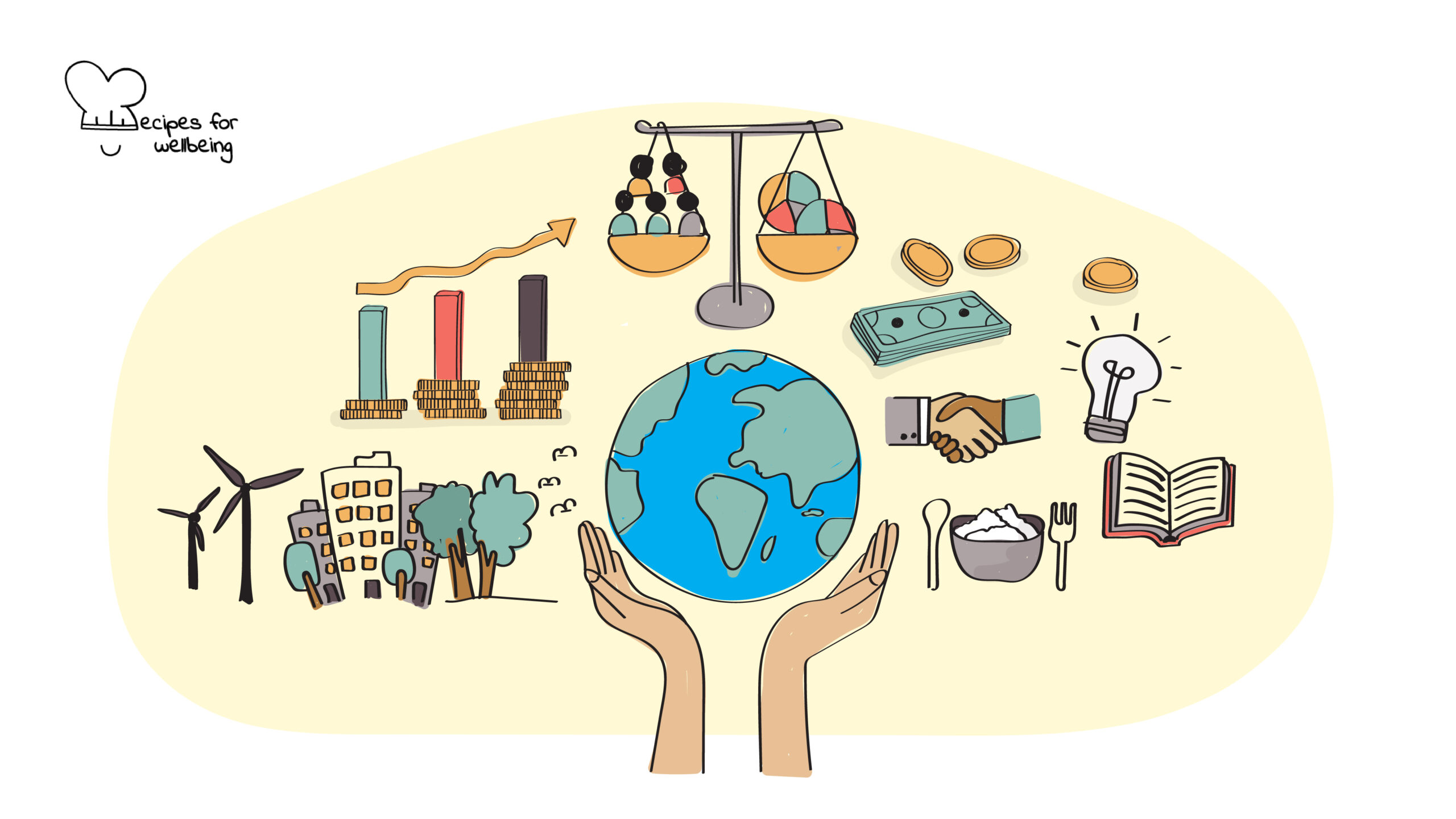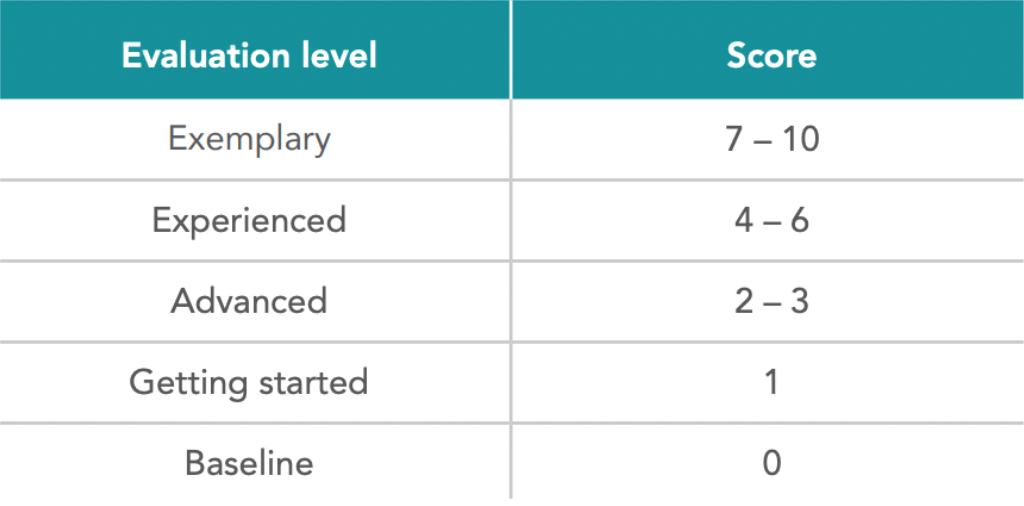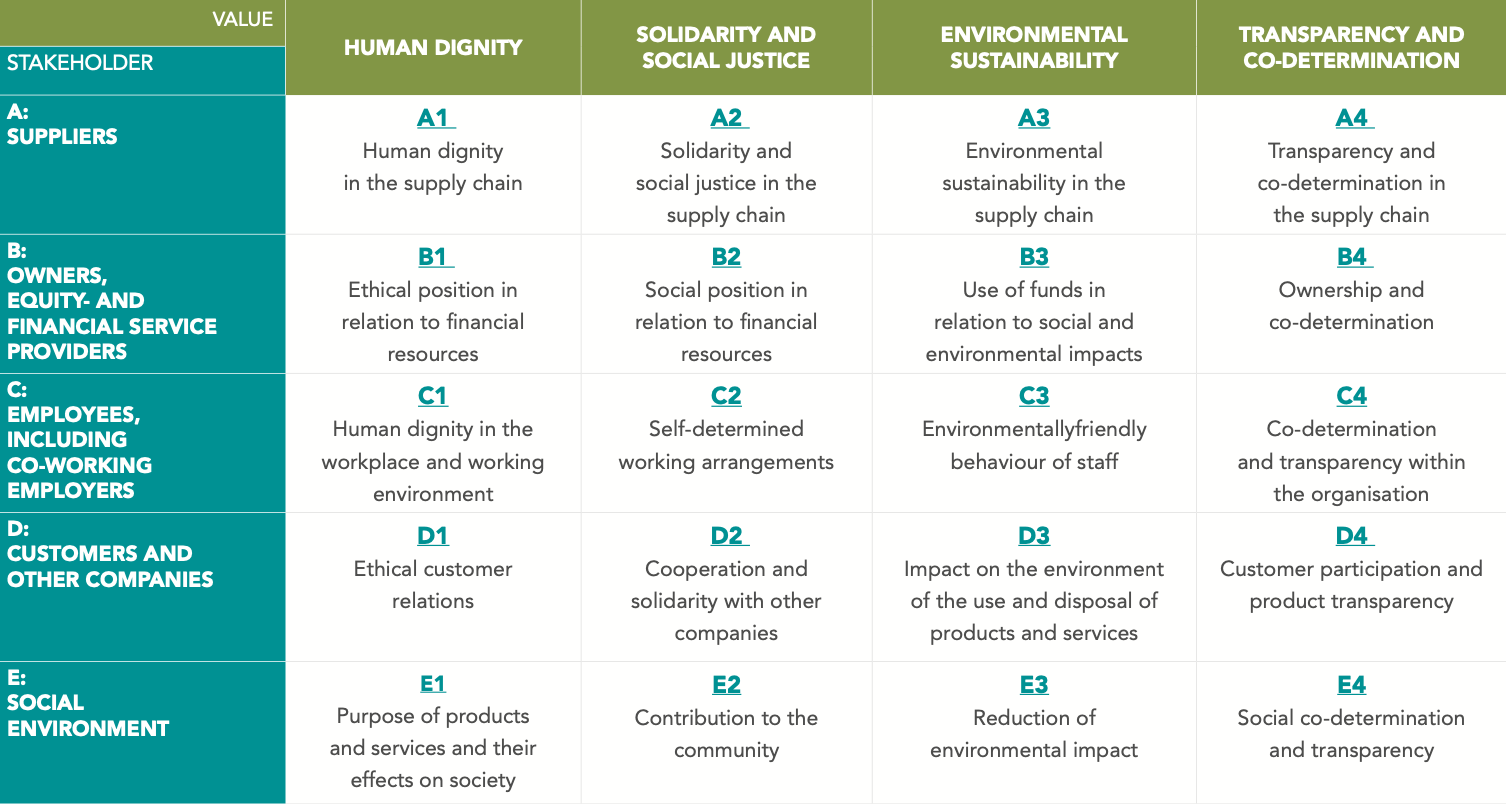
Economy for the Common Good
No decisions should ever be made without asking the question, is this for the common good? ―Michael Moore
👥 Serves: 26-40 people, 41+ people
🎚 Difficulty: Hard
⏳ Total time: 1 day
🥣 Ingredients: ECG workbook, report template, balance sheet calculator, report guidelines and ECG consultants (optional)
🤓 Wholebeing Domains: Bioempathy, Community
💪 Wholebeing Skills: Collaboration, Ecosystem harmony, Inclusion, Nature kinship, Non-extracting

Economy for the Common Good
📝 Description
Create an economy that benefits everyone, including the planet.
The Gross Domestic Product (GPD) measures the monetary values of goods and services in a country over a predetermined set of time, typically every 3–4 months or annually and has been a favoured measurement since 1934. However, many changemakers and economists are beginning to question the value of the GDP. Can it really tell us how a community/organisation is doing? Can it measure sustainable environmental practices, the happiness and health of a community’s people, or if a community is making decisions democratically?
Well, not really, no!
In 2010, Christian Felber coined the term “Gemeinwohl-Ökonomie”, or Economy for the Common Good (ECG). The ECG is, at its core, an economic model that moves away from looking just into an area’s monetary success to practices of a good life for everybody. The values of ECG are:
- Human dignity;
- Solidarity and social justice;
- Environmental sustainability; and
- Transparency and co-determination.
By imploring the values of ECG, ECG strives to support communities and organisations to connect with each other through mutual respect and diversity, while allowing them to be active participants in the political arena – making resolute, democratic decisions that impact their present and future. It also allows individuals to construct personal goals while understanding their full potential through the development of new skills, which ultimately, supports the expansion and success of the ECG model. The ECG can be used by organisations/companies and municipalities/communities.
This recipe has been adapted from the work of Christian Felber, internationally renowned speaker, contemporary dancer, author of 15 books, university lecturer at Vienna University for Applied Arts and research fellow at The Institute for Advanced Sustainability Studies of Berlin by our wellbeing content writer collaborator Marissa Del Mistro.
👣 Steps
Step 1 – Take the Common Good Report quiz (30’, optional)
Creating a Common Good Report requires time and space for reflection. Before the actual report, you may wish to complete the 30-minute quiz. The quiz intends to help your group develop a better understanding of the process, and how you might already be operating within ECG principles. The quiz consists of 30 questions that you self-evaluate and score. Questions include, for example:
- What does human dignity in the workplace mean for our company, and how can we bring more humanity to our company?
- What measures have been implemented toward occupational health and safety and how is diversity promoted? How are they evaluated?
- How do we influence nutrition during working hours?
- How do we deal with mobility and how do our employees commute to and from the workplace?
- In which areas does the company cooperate with other companies or does it act in solidarity and provide assistance?
- In what ways does the business model take account of the issues of consistency, efficiency, and sufficiency?
The score will provide a compass of your Common Good orientation, along with a space for reflection on the issues raised by each question.
Step 2 – Determine your evaluation model (5’)
The next step is to determine which evaluation model is best for your Common Good Report.
- Option 1: Internal • You can do it internally, with just your group, and no external support. This is entirely possible as the materials are available online and written in an accessible manner.
- Option 2: ECG Consultants • You may prefer to work with an ECG consultant who can support the report writing and make adjustments to the report according to the individual needs of your organisation/community. For information about working with ECG consultants, please contact [email protected]. Please note working with an ECG consultant includes a fee.
- Option 3: Peer Group • You could also opt for working with other organisations that are undertaking the report. The peer group consists of 4-6 other groups and is supplemented by ECG consultants. The groups will still craft their own personalised report, which will take about 6 months to complete and includes an extensive peer evaluation. To learn more about this route, contact [email protected]. Please note that this option will only work with groups with less than 30 people involved and includes a fee.
Step 3 – Select your Common Good Report (5’)
For this step, you must pick which report type you will use, based on your organisation/community size. There are two types of Common Good Balance Sheet – a comprehensive and a compact version. For the sake of this recipe and demonstration purposes, the following steps will focus on the comprehensive Common Good Report.
Step 4 – Write the report (3–5 hours)
Download all the materials necessary for writing the report, including a guiding workbook, template, and balance sheet calculator. Please note that a Common Good Report is based on the principles of ECG. All answers and descriptions provided need to be based on tangible evidence and should cover a two-year period.
The initial questions in the report act as an introduction to each theme, while the questions for compiling the report relate directly to the information required to make an evaluation. There are compulsory indicators in which your organisation/community can make its own decision regarding what content to include, but it should be presented clearly and comprehensively to facilitate the audit of the report, which happens later.
The Common Good Matrix is the framework for the evaluation. It comprises 20 Common Good themes on what will be evaluated (summarised in the image below).
Let’s break down what the report will ask for, using the first factor, A1 of Human Dignity.
Questions for discussion:
- What goods and services are purchased? What are the criteria for selecting suppliers?
- How are social risks in the supply chain assessed?
- How are violations of human dignity in the supply chain identified?
- What influence is exerted on suppliers to ensure they respect the human dignity of all stakeholders?
- What certification do purchased products have?
Compulsory indicators:
- Percentage of the total purchasing volume represented by goods and services expressed in tabular form.
- Percentage of purchased goods and services provided under fair working conditions.
Additional areas to work through:
- During the reporting period, the following measures have been implemented: ___________.
- Areas for improvement/ objectives: ___________.
- Which links in the supply chain pose a particular threat to human dignity?
- What measures are being taken to reduce and prevent these effects?
- The proportion of purchased products that are ethically risky vs those that are ethically harmless.
The next is evaluation, to show the true impact of the organisations/communities on the common good, by placing itself along a scale from baseline to exemplary.
This is the evaluation level and score – with each evaluation level given a score depending on how ECG-driven the theme is, and the extent to which the criteria for each level have been met.

Note:
- Every aspect is rated on a scale from 0 to 10 and is weighted according to its relevant importance within each theme (low/medium/high/very high).
- Each theme is evaluated using the Balance Sheet calculator. This is a simple, automated aggregation of all the scores of each aspect according to their relative weighting. The more important an aspect is for the common good, the greater its overall value within the theme. The overall value of a theme is rated on a scale from 0 to 10.
- Then, the Balance sheet calculator is used. The maximum number of Common Good Points which can be scored 1,000 and the minimum is a negative score of -3,600.
- Each of the 20 aforementioned themes is allocated an equal score of 50 points. To determine the overall score, the balance sheet calculator adjusts the weighting for each theme according to the following factors:
- The size of the company;
- Financial flow to and from suppliers, investors, and employees;
- The social impact of the main primary products in their country of origin; and
- The industry sector and its associated environmental and social impact.
Step 5 – External audit (2 hours)
The external audit is the final step before publishing your Common Good Report. The audit involves independent evaluation, feedback, and suggestions for future development. It will be completed by a certified and independent entity, to ensure the quality and no lack of bias. Auditing can be done in two ways:
- The first method is by peer evaluation. Peer evaluation works with other companies/communities by evaluating each company/community’s contribution to the common good. The audit is then finalised by an ECG consultant.
- The second method is to have your report audited by an external audit. This route can be done by either a visiting audit or a desk audit.
Regardless of which method your report is audited, the results are displayed in a certificate. Please note to do an audit, you must be a member of the ECG.
Step 6 – Publish your audited report (20’)
Now you can publish your report, which will join the ranks of other ECG reports on the online platform. You can use your report as powerful marketing material and to increase your credibility, especially if you intend to use the report for data and “proof” with stakeholders.
Step 7 – Make your report work for you (ongoing)
- Organisations/Companies
By imploring the values of the ECG, organisations become more innovative and dedicated to the common good and interest of all – including the environment. One interesting success story is:
“With the aim of donating a large part of the profits to ecological, social, and cultural causes, the online book company buch7 was founded as a limited liability company in 2008. In the beginning, the founders worked for free, so that half of the first profits were donated. After a long build-up phase, the breakthrough came in 2013, as a result of a high-profile documentary about working conditions at Amazon. Today, buch7 is a company with nine employees, over two million euros in sales and a cumulative donation of over 500,000 euros, which corresponds to about 75 percent of profits. Donations are made bureaucratically for small projects.”
The ECG promotes your organisation to:
- Experience 360° sustainability management;
- Improve relationships and understanding of others;
- Increase motivation in the workplace;
- Innovation impetus; and
- Meet the EU’s non-financial information reporting requirements (if based in Europe).
Explore the various organisations/companies around the world that have completed a common good report on the interactive world map.
- Community/Municipal government
After crafting the report, the ECG values can spark new ideas and tools for communities and municipalities. Examples include:
- Educating local small businesses/other organisations on the values of ECG and encouraging them to do their own report. If you do, make sure to highlight them! Share their information on tourist information, award them with ECG awards, provide a platform for them to share their accomplishments, and favour these places when awarding contracts or making purchases.
- Involving citizens in the annual review of the report and engaging them to take steps to improve the quality of life based on the results from the polls.
- Creating a local economic convention for interested community members/citizens to use to discuss the report, issues to focus on, research, vote, etc.
- Initiating or joining a “Common Good Region” for a province, district, quarter, or state, whose aim is to turn as many municipalities as possible into Common Good Municipalities! You can work together with them to manage, promote and grow.
The ECG promotes your community/municipal government to:
- Share common values;
- Improve the overall quality of life;
- Focus on the precious preservation of nature and environment; and
- Focus on fair and sustainable products and services.


